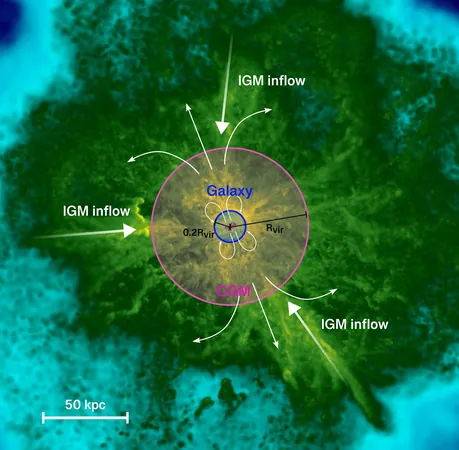
Unlocking the Mysteries of Dwarf Galaxies: New Simulations Reveal Stellar Secrets
2025-07-22
Author: Mei
In the grand tapestry of cosmic evolution, dwarf galaxies—though diminutive—play a monumental role as the backbone of the universe's structure. These tiny stellar islands are not just a prelude to massive galaxies like our Milky Way; they hold vital insights into the genesis of the first stars and black holes.
Historically, the study of dwarf galaxies has posed significant challenges for scientists due to their low mass and the complex interactions with their gaseous surroundings. However, recent groundbreaking research led by Pei-Cheng Tung and Ke-Jung Chen from the Institute of Astronomy and Astrophysics at Academia Sinica has turned a corner in our understanding.
Revolutionary Simulations Unveiled
Employing the state-of-the-art cosmological simulation known as IllustrisTNG, the researchers utilized the innovative GIZMO simulation code, employing a technique called "Particle Splitting" to dramatically enhance the resolution of galaxy simulations a hundredfold. This leap in technology enabled them to delve deeper into the intricate gas structures and metal flows surrounding dwarf galaxies.
This undertaking represents one of the highest resolution simulations globally focused on low-mass galaxies, made possible by supercomputing resources at Lawrence Berkeley National Laboratory. The results of these intensive simulations shed light on how star formation is intricately linked to cold gas supply from the circumgalactic medium (CGM). Astonishingly, between 40% to 70% of a galaxy's mass is derived from gas inflows, with almost half of the cold gas for star formation being recycled from the CGM—illustrating a dynamic, interactive "ecosystem".
Recycling Stardust and Fueling Black Holes
The findings also track how stardust is circulated back into the CGM through galactic winds, cooling down and influencing future star formation. In a striking revelation, the simulations indicate that even during the early epochs of the universe, black holes at dwarf galaxy centers exhibit fluctuating accretion activity, reinforcing the theory that these galaxies could be the birthplaces of supermassive black hole seeds. This aligns perfectly with observations from the James Webb Space Telescope regarding the formation of active galactic nuclei.
A New Era for Astronomy
The implications of this study are profound. Not only does it set a new standard for modeling dwarf galaxy evolution, but it also equips future observational missions—including the JWST and the upcoming Nancy Grace Roman Space Telescope—with concrete predictions. These predictions encompass the distribution of temperatures and metals in the CGM, the effects of black hole growth on galaxy brightness, and the recycling timescales of metals in low-mass galaxies.
As Dr. Ke-Jung Chen remarks, "This study heralds a new age where theoretical simulations attain the precision necessary to reflect observational truths, allowing us to quantitatively investigate the essence of small galaxies in the early universe. With this synergy between simulation data and observational findings, we are on the brink of unearthing fundamental truths about the origins of galaxies and the evolution of black holes."

 Brasil (PT)
Brasil (PT)
 Canada (EN)
Canada (EN)
 Chile (ES)
Chile (ES)
 Česko (CS)
Česko (CS)
 대한민국 (KO)
대한민국 (KO)
 España (ES)
España (ES)
 France (FR)
France (FR)
 Hong Kong (EN)
Hong Kong (EN)
 Italia (IT)
Italia (IT)
 日本 (JA)
日本 (JA)
 Magyarország (HU)
Magyarország (HU)
 Norge (NO)
Norge (NO)
 Polska (PL)
Polska (PL)
 Schweiz (DE)
Schweiz (DE)
 Singapore (EN)
Singapore (EN)
 Sverige (SV)
Sverige (SV)
 Suomi (FI)
Suomi (FI)
 Türkiye (TR)
Türkiye (TR)
 الإمارات العربية المتحدة (AR)
الإمارات العربية المتحدة (AR)